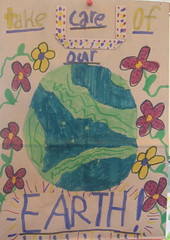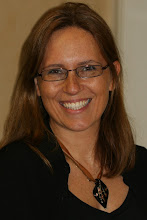
Mark Ahlness talks about his remarkable project The Earth Day Groceries Project for which children decorate grocery bags for their local grocery store. At first I thought "how cute!" It seemed like a nice way for children to get involved in Earth Day, interact with the community, and do a little research on environmentalism. As I was reading, I had mental images of children using the internet to find information before decorating their bags. Nice, but not something that teaches me better use of technology...and that is why I'm reading the book.
Then Ahlness begans to explain how the project developed. I literally had an aha! moment. This project was so much more than merely Googling 'environment' and making some notes:
By spreading the word about the project, Ahlness was encouraged to develop his own skills in web creation. He also discovered interesting ways to communicate and use listservs such as Ednet (www.umas.edu/ednet), thus enabling him to 'expand the boundaries of his classroom' further.
Because Ahlness requested feedback from participants in the project, he found the need to re-evaluate his technology skills regularly. He states that participation grew to a staggering 188 schools by 1996. Having checked out the website, I have read that over 1200 schools participated in 1999. I could not find numbers for this year, but did find a cool link that lets you read the feedback from participating schools across the nation. There is also a blog which shows a new addition to the project, a school from Sri Lanka. Wow! To accommodate this growth, Ahlness had to find new ways of processing the information sent to him by the schools. He established a new website and database, sponsored by the American Forest and Paper Association. He had to grow with the project.
Through this amazing growth, the project has taken on an interdisciplinary opportunity for teaching. It is no longer a basic research project. Schools are invited to use the website http://www.earthdaybags.org/ to interact in many ways. They may use the free downloads provided by the site (desktop wallpaper, PowerPoint presentations, drawing templates, clip art and screen savers) and can instruct students in using them to create their own Earth Day webpage on which Ahlness encourages schools to post pictures of their bags and feedback about the project.
Geography skills can be enhanced as students track the locations of the participating schools. Follow-up can be done on the natural resources and environmental issues pertaining to that area or country. There is even a wonderful math opportunity on the site as it posts figures relating to the number of bags each school produced.
Not all of his learning was positive. Ahlness comments on the issues of copyright and how his work has been used both with and without permission.
As I am writing this I am not sure that my point is coming across. Learning is a two way street. This project reminded me of the way teachers learn just as the students do...provided they are prepared to move forward and take some chances. This is a project that I would love to introduce to my school but I am afraid that I do not possess the skills involved. I should take the path taken by Ahlness and 'try it'. I need to grow in my own skills and this learning will also provide my students with a wonderful and meaningful learning experience. Who knows, I may even help to protect out world!
Image taken from http://static.flickr.com/8/10405335_0221aa1c6c_m.jpg

No comments:
Post a Comment